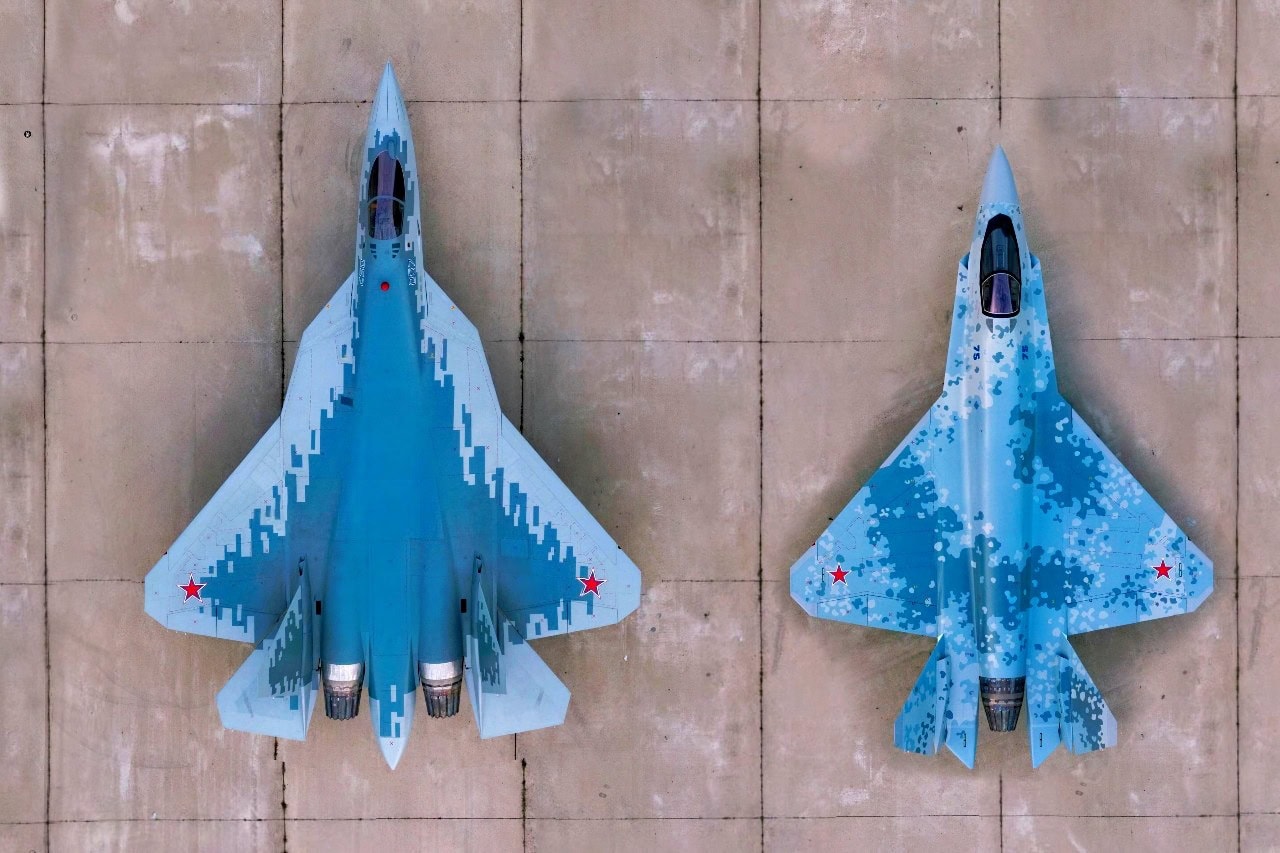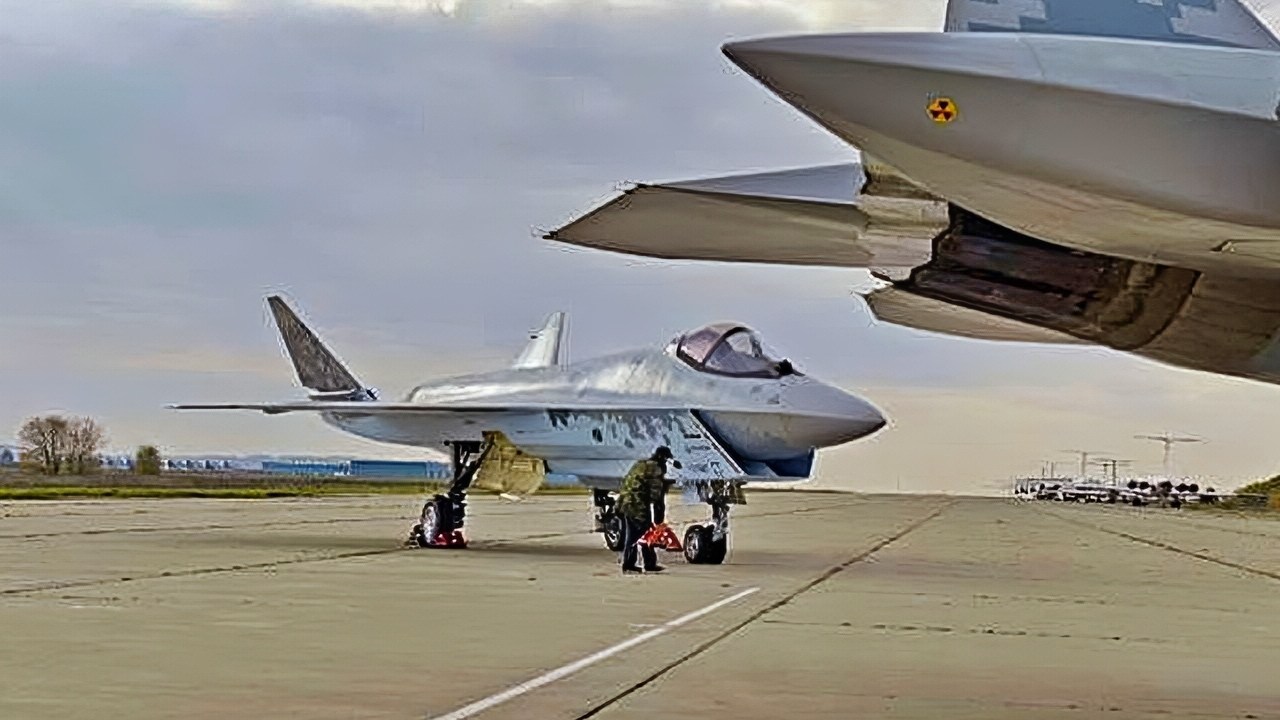Key Points and Summary – Russia’s Su-75 Checkmate, unveiled in 2021 as a “cheap” $30 million 5th-generation F-35 rival, appears to be a “laughably optimistic” failure.
-Pitched to export customers in Asia and the Middle East, the program has been crippled by Western sanctions, which block access to critical components and machinery.

Su-75 Checkmate and Su-57. Image Credit: Creative Commons.
-It’s been promised that the first 2023 flight would never happen, and key potential partners like India and the UAE have all turned down the offer.
-The Su-75 is now seen less as a real aircraft and more as a propaganda “phantom” jet, far beyond Russia’s war-strained industrial capacity.
-In fact, the fighter has a dark secret: it will likely end up a failure.
Russia’s Su-75 – Is It Really A “Checkmate”?
In July 2021, Sukhoi, the Russian aircraft manufacturer, unveiled the Su-75 Checkmate at the MAKS air show, pitching it as a single-engine, affordable fifth-generation stealth fighter intended for both export and domestic service.
Officials said that the aim was to achieve a cost of roughly $25-30 million USD, aiming to undercut Western rivals such as the F-35 Lightning II.
Should it all go to plan, Russia would become a global provider of fifth-generation stealth fighter platforms to countries willing to save money by doing business with the government.
In many ways, the idea makes sense. Russia has long operated heavy twin-engine fighters domestically, like the Su-57, but lacks a mass-export-friendly stealth platform. Not only that, but with Western sanctions still biting, Moscow sees exports as a revenue-driving opportunity—and the Checkmate was explicitly marketed to countries in Asia, Africa, and the Middle East.

Su-75 Checkmate. Image Credit: Creative Commons.
In other words, Russia wants business from countries less likely to prefer doing business with the United States.
But not all has gone to plan. Even during its launch, the program appeared to be a signaling opportunity—and less of a realistic pitch.
Russia did, in fact, pitch itself as technologically competitive in stealth fighters and aimed to spook the West by signaling that it was becoming more competent at developing fully indigenous systems.
But delivering it is another story, and arguably the whole plan was based on unwarranted optimism.
Technical Claims
According to public claims and Russian design documentation, the Su-75 Checkmate is projected to reach speeds of Mach 1.8 to 2, a combat radius of approximately 3,000 km, and a payload capacity of up to 7,400 kg.
As for its design, the aircraft is planned to include a diverterless supersonic inlet (DSI), a v-tail configuration, and internal weapons bays and avionics from the Su-57 platform to reduce costs.
Now, if these specs were realized, it would firmly place the Checkmate in the ballpark of the F-35, which has a top speed of around Mach 1.6, and nearer the lower end of the heavier twin-engine F-22’s performance, at roughly Mach 2.2+. It would fit the “stealth for less” marketing pitch perfectly.
However, key capabilities of this aircraft remain unverified. We don’t know its radar cross-section, we don’t know its sensor fusion abilities, we know nothing about sustainment or maintenance costs, nor do we understand its data-link interoperability. None of these details has been specified or detailed by the Russians, and anything we do know is yet to be independently verified.

Su-57 and Su-75. Image Credit: Artist Rendering/Creative Commons.
And that’s significant because Western analysts have described mainly the aircraft as a project completely out of sync with Russia’s current industrial capacity. In simple terms, Russia doesn’t have the resources to build it.
Crucially, this notion of a “cheap” stealth option is historically complex to deliver and, to be blunt, laughably optimistic.
Western experience in this field shows that fifth-generation fighters require more than just stealth shaping; they need advanced materials and coatings, great supply chains, sensors, pilot training, maintenance infrastructure, logistics, and more.
None of these things is cheap, and they only become more affordable at scale.
For a truly “cheap” stealth option to exist, vast numbers of these aircraft would need to be developed, and massive infrastructure would need to be built to ensure they can be maintained appropriately when not in use.
A historically good example of how stealth coatings require extensive maintenance and care, particularly when less advanced, is America’s B-2 Spirit stealth bomber.
The iconic bomber requires constant maintenance and is stored in specialist hangars to ensure its stealth coating remains in good condition.
If the U.S. struggles to produce “cheap” stealth, then it’s hard to imagine how Russia would do it.
Progress, Constraints, and Why It May Not Happen
While Russia continues to claim the program is entering its final stages, the reality is that significant delays and obstacles remain—and there’s no telling when the project might finally come to fruition.
Initial flight tests for the Su-75 have been delayed repeatedly. Originally scheduled for 2023, the tests have yet to happen.
Sanctions are just one part of the puzzle here, but they’re arguably the most significant part. Leaked internal Russian industry documents show that Western embargoes have blocked access to key components needed to build the aircraft, from advanced gear-shaping machines and semiconductors to foreign investment.

Su-75 Checkmate Fighter X Screenshot. Image Credit: X.
Russia simply cannot access the things it needs to make the aircraft a reality. In fact, one report noted that delivery times for key machines required to build the plane had stretched beyond 15 months, and that domestic substitutes were lagging.
Add to that the fact that the Russian aerospace-defense complex has been redirected to focus on the war in Ukraine, and the fact that countries like India, the UAE, and Vietnam have all turned down the offer to purchase the platform.
It’s clear that a project like this simply isn’t on the cards for Russia any time soon. And even if it’s made—as some reports have noted, it was spotted in a photo released by the Russian United Aircraft Corporation—the idea that it will be “cheap” or widely exported is still very much in doubt.
About the Author:
Jack Buckby is a British author, counter-extremism researcher, and journalist based in New York. Reporting on the U.K., Europe, and the U.S., he works to analyze and understand left-wing and right-wing radicalization, and reports on Western governments’ approaches to the pressing issues of today. His books and research papers explore these themes and propose pragmatic solutions to our increasingly polarized society. His latest book is The Truth Teller: RFK Jr. and the Case for a Post-Partisan Presidency.
More Military
China’s New J-35 Navy Stealth Fighter Summed Up in 2 Words
China’s ‘Mighty Dragon’ J-20 Air Force Stealth Fighter Summed Up in 2 Words
China Is Trying to Turn the Indo-Pacific Into a Giant U.S. Navy ‘No-Go Zone’
$13 Billion Mistake? USS Gerald R. Ford Is the Navy’s Aircraft Carrier Agony
China’s ‘Thousands of Missiles’ Have a Message for U.S. Navy Aircraft Carriers










